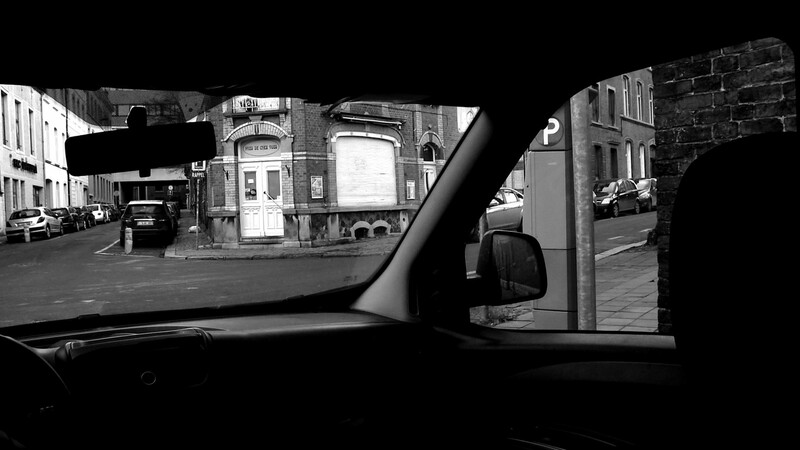
Bringing together works by Berlin-based artists Emma Waltraud Howes and Stine Marie Jacobsen, the distance between nowhere and now here addresses implications of distance, casualties of dislocation, and other consequences of disembodiment. The exhibition is an occasion to reflect on manifestations of presence and negotiations of absence, and everything in-between: between nowhere and now here, translation is fundamental.
If translation is a movement, a linear geometrical displacement that supposedly leaves its object unchanged, it is also a performance, an interpretation of an original work. Based on Samuel Beckett's short play Not I (1972), Howes' installation Stage Directions for a Mouth (2014) allies video, sculpture and text. The reconfiguration of dislocated elements dissects choreographies of speech, disjoints acts of language, and probes the agency of performance. Jacobsen's Mann beißt Hund (2015) is a remake of the Belgian film C’est arrivé près de chez vous (translated as Man Bites Dog, 1992) devoid of human presence. Presented along with the map of the shooting locations and a review of the original film, the work foregrounds articulations of structural, symbolic, and physical violence. the distance between nowhere and now here takes its cue from these methodologies and unfolds in absentia. At times literally standing in for the artists, often conjugating works to local contexts, the curator’s translation—be it concerted or violent—is always critical.
A reader usually encounters a translation in ignorance of the original. It is, for all intents and purposes, the raison d’être of translation: to make a work accessible to those who cannot grasp it otherwise. How does one know a translation to be ‘faithful’? Usually, one does not. Usually, the translator cannot accomplish such a task except at the expense of either form or content. Loyalty to one means the other has to be altered in the process, and in both cases meaning is affected. Faithfulness to the author is faithlessness to the reader, and vice versa. But the messiness of language (and art) never lends itself so simply to this binary. Experiencing a translation is a gesture of trust as much as accepting an apology. Declaring a translation a translation is a speech act, and believing it is a leap of faith. There are so many ways this can go wrong.
In Beckett’s play Not I, a bodiless mouth delivers a barely intelligible flow of words, floating eight feet above an otherwise pitch-black stage. Howes’ Stage Directions for a Mouth echoes the unsettling stream of consciousness at once unleashed and disavowed by Mouth in Not I. The installation proposes alternatives to language as means of agency – when utterance is silenced, lost, impossible or just not enough. The artist’s reflection arises from occurrences of speech repression and consequent protest strategies, such as the casseroles demonstrations in Québec in 20121, themselves citing the Latin American cacerolazo tradition. The reconstitution of the work in Toronto, the reconfiguration of the installation into the gallery space, and its recontextualization in this exhibition called for abundant forms of communication, making up for various physical gaps. The metal mouths that emerged from these exchanges attempt to shape absences, compensate lacks, embrace misunderstandings, and speak for themselves, while no prompter is there to whisper cues.
Jacobsen conceptualized Mann beiβt Hund in Belgium in 2013, concurrently with protests against poorly written legislations of public space and their abusive misuse by government officers. Belgian citizens saw C’est arrivé près de chez vous – a mockumentary following a serial killer’s daily routine – as an illustration of the dangerous slippage from individual discretionary power to collective social disaster. In its initial iteration, Mann beiβt Hund included workshops about law writing with teenagers, developed in collaboration with a local lawyer. Displacing the piece into a North-American context, some translation was unavoidable: we asked two Toronto lawyers to write a film review, namely a reading of the original film through the lens of the local legal context, specifically drawing analogies with issues of immigration detention in Canada.2
Translation involves shifts in meaning. The attention to curatorial translation, when working closely (from a distance) with both artists, revealed its potential. The process has been generative and resulted in the production of new elements adapting the projects to current contexts, whether discursive, material, intimate, or political. These new works act as collaborative neologisms of some sort, where author and translator meet, and render visible the distance between nowhere and now here.
View the exhibition website.
the distance between nowhere and now here
Curated by Charlotte Lalou Rousseau
- Curator
- Charlotte Lalou Rousseau
Presented in collaboration with the Images Festival, April 14–23, 2016, and with Scotiabank CONTACT Photography Festival, May 1–31, 2016. For more information visit imagesfestival.com and scotiabankcontactphoto.com
The Blackwood Gallery is supported by the Canada Council for the Arts and the Ontario Arts Council.






The Blackwood
University of Toronto Mississauga
3359 Mississauga Road
Mississauga, ON L5L 1C6
[email protected]
(905) 828-3789
The galleries are currently open. Hours of operation: Monday–Saturday, 12–5pm, Wednesdays until 8pm.
Facebook | Twitter | Instagram
Sign up to receive our newsletter.
The Blackwood is situated on the Territory of the Mississaugas of the Credit, Seneca, and Huron-Wendat.
